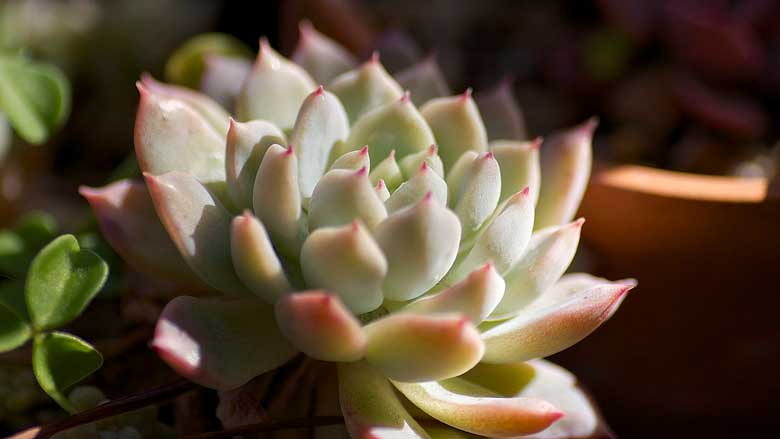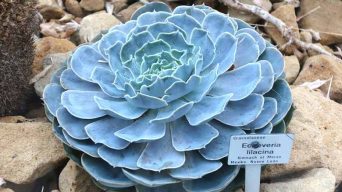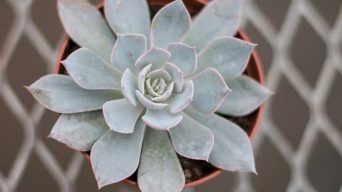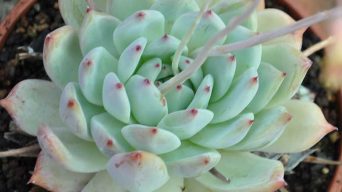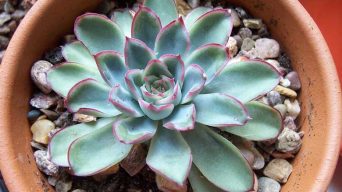Echeveria plants are well known for their attractive appearance and the ease with which they can be grown.
The Echeveria prolifica species is no exception to that rule.
These plants are well suited for windowsill culture because they tolerate dry soil conditions. Still, they can also be planted outside in sunny gardens when temperatures are warm enough to avoid any risk of frost damage.
Here is a complete guide about caring for and propagating the Echeveria prolifica succulent plant.
Overview
Echeveria prolifica, also known as the Prolific Echeveria, is a fast-growing succulent plant, perennial in nature, of the Crassulaceae family native to Mexico.
Echeveria prolifica plants are small clustering succulents with rosettes that only grow about 2-4 inches broad.
However, because of the number of pups and offshoots they produce, they expand quickly to form a large clump.
The small bell-shaped flowers bloom in early spring and throughout the summer, with yellow petals contained in compact clusters at the end of long stems.
How To Care for Echeveria Prolifica (Prolific Echeveria)
Echeveria care is pretty simple. It doesn’t need much attention or maintenance to thrive, but it appreciates a few things that will help it flourish.
Below you’ll find the most important information you need to know about caring for Echeveria prolifica.
Sun Exposure & Light Requirements
Echeveria prolifica succulent plants thrive in full sun to partial shade exposure. They need at least 6 hours of sunlight every day.
A bright indirect light is ideal, but avoid direct sunlight as it could burn the leaves of this plant.
Echeveria prolifica succulent plants should not be exposed to direct sun in the hottest part of the day. They will tolerate full sun exposure but might suffer/burn slightly in extreme heat.
Echeveria prolifica are considered an outdoor plant, but they can also be grown indoors in sunny areas of the home – near an east- or west-facing window.
Echeveria prolifica succulent plants need bright light to maintain their color and elegant shape. If given low light, they will grow more leggy and elongated than what is typical for this plant.
Watering Requirements
Echeveria prolifica is an easy plant to water – it requires watering once a week. Still, it may need more or less, depending on the humidity.
If you have your succulent in a very bright environment with direct sunlight, it will require more frequent watering.
The soil should be dry before watering. This means if the soil is still damp after one week, don’t water it. Let the soil dry out first before watering again.
Do not overwater your succulent plant – this is especially important for people that tend to kill plants through oversaturation!
I know you want to water them daily because they look like they are dying, but try only to water once a week instead!
Soil Requirements
Echeveria prolifica grows well in well-draining soil.
Well-draining soils allow water to drain quickly and reduce the chance of root rot and other diseases that thrive in damp soil. The soil should also be able to retain moisture well.
A cactus soil mix is one of the most successful mixes for growing Echeveria. This allows the soil to retain adequate moisture while still draining correctly.
If you have to use a different potting mix, add plenty of perlite and coarse sand to the mix. Perlite and coarse sand will increase drainage in regular potting soil.
Alternatively, a layer of gravel at the bottom of a container can promote drainage.
Temperature and Humidity
Echeveria prolifica is tolerant of a wide range of temperatures, but it will do best if kept between 65°F and 80°F.
Ideally, the temperature should be closer to 70°F. It can not tolerate cold drafts or extreme heat, so keeping the plant away from either source is best.
When temperatures drop below about 50°F, the plant’s growth slows down dramatically.
It is best to keep temperature swings minimal to avoid stressing your Echeveria prolifica succulent plant.
In terms of humidity, Echeveria prolifica will do best around 40% relative humidity. 50% is the upper bound for comfortable humidity levels, so be sure to avoid getting above that.
Fertilizing
Echeveria prolifica plants have a low nutritional demand, so fertilizing is not necessary.
If you want to fertilize, use a balanced liquid fertilizer diluted to half-strength during the growing season.
Gently sprinkle the fertilizer on top of the soil. If you notice leaves starting to yellow, discontinue fertilizing your plant.
Echeveria prolifica is sensitive to overfertilization. Overfertilized plants have weak, floppy stems and pale yellow to white leaves.
If you want your plant to remain healthy for a long time, never fertilize more than once or twice during the growing season.
Potting and Repotting
Echeveria should be repotted every one to two years.
The best time for transplanting Echeverias is spring or early summer. This way, you will give them enough time to take root before the hot summer weather sets in.
When you feel the roots of the Echeveria are filling up their pot, it is time to repot. Always use fresh soil when repotting to keep your Echeverias healthy and strong.
When transplanting your Echeveria prolifica, try to disturb the roots as little as possible. This way, it will quickly reestablish its delicate, shallow roots, which it uses to absorb water and nutrients.
Terracotta and unglazed pots with drainage holes work best for succulents, as glazed pots retain water and can cause root rot. If you use a glazed pot, make sure the container has ample drainage holes.
Choosing a pot slightly larger than the previous one is important because roots grow quickly and will soon fill up their pots if they have adequate space.
Pruning
Echeveria prolifica is a small, fast-growing succulent plant that only needs occasional pruning.
Under usual circumstances, you will never need to prune this succulent. Still, if it becomes overgrown or starts growing weirdly, you can do so.
Echeveria prolifica is a naturally fast-growing plant – which means that if left unattended for long periods, it will start to grow in strange ways and might even become a giant, tangled mess.
It’s recommended that you prune your plant as soon as you notice it getting weirdly shaped or too big for the spot where you have planted it.
If pruning is needed, it should be done shortly after flowering with clean shears.
Pruning off the succulent plant’s damaged, dying, or dead leaves will promote new growth and prevent diseases.
Pests and Diseases
The Echeveria prolifica succulent can be affected by several pests and diseases.
The two most common problems that affect the plant are:
Mealybugs
Mealybugs are small, soft-bodied insects covered in a waxy powder and come in many colors, including white, pink, yellow, and green.
They affect Echeveria prolifica by sucking sap from the plant tissue, which causes the plant to stop growing.
Mealybugs also cause leaves to turn yellow and fall off, especially in dryer conditions.
Root rot
Root rot is caused when roots are exposed to cold or hot water for too long, then not properly dried before being placed back into the soil.
It’s characterized by dark brown or black discoloration at the base of the plant’s stem.
The Echeveria prolifica succulent is also more susceptible to root rot if planted in a container with drainage holes, as it will have trouble drying out completely.
How to Care for Echeveria Prolifica in Winter
Echeveria prolifica plants are not cold-hardy and should be wintered indoors. When temperatures fall below 50 degrees Fahrenheit (10 degrees Celsius) in late autumn or winter, you should take your Echeveria prolifica plant inside.
You should place your Echeveria prolifica in an area where it will get bright, indirect light. If possible, place the plant near a window so that it can get some sunlight to photosynthesize during the day.
You should also reduce watering during the winter. Decrease watering to once every two weeks, ensuring that soil is dry to the touch between watering.
Keep the plant away from heating vents, fireplaces, and other drafty areas of the house. Drafts can cause leaves to dry out and die prematurely.
Also, Echeveria prolifica should not receive any fertilizer during winter because the reduced light levels will not be enough to sustain it.
If you live in an area where winters are mild with no freeze, you can leave your Echeveria prolifica outside during winter.
How To Propagate Echeveria Prolifica
Echeveria prolifica can be easily propagated from leaf cuttings and offsets.
However, it is advised that you propagate from offsets rather than leaves, as they have a higher success rate.
Propagating Echeveria Prolifica From Offsets
Offsets are baby Echeveria prolifica plants that grow on the mother plant. They can be easily removed by hand or with a sharp knife without hurting the parent plant.
To propagate Echeveria prolifica from offsets:
- Gently pull the offset from the side of the plant, being careful not to rip it off.
- Place the offset on top of some soil and cover it with a thin layer of soil. Be careful not to bury the offset in the ground too deep, but you don’t want it exposed at the top either.
- Water the offsets well, just enough for the water/soil mix to hold together. The offset should be moist but not drenched in water.
- The offsets should begin growing new roots in about a month.
- The offset can be replanted independently when it has grown at least two or three new leaves.
Propagating Echeveria Prolifica From Leaves
Leaf cuttings are an easy way to propagate Echeveria prolifica; however, it is not a sure shot.
Though they have a very good success rate if done correctly, the time spent is worth it.
To propagate Echeveria prolifica from leaves:
- Use a sharp knife or scissors to remove four to five small leaf cuttings from the parent plant.
- Let the cuttings dry out for a few days.
- Place the leaf cuttings on top of some soil and cover them with a thin layer of soil. Be careful not to bury the leaves in the ground too deep, but you don’t want them exposed at the top either.
- Water well, just enough so that the water/soil mix holds together. The leaves should be moist but not drenched in water.
- The leaves should begin growing roots in a few weeks.
- When the leaf cuttings have grown at least two new leaves, they can be planted independently into separate containers or pots.
Final Thoughts
Growing succulents is a rewarding and straightforward process once you know what you’re doing.
Many succulents are perfect for indoor growth, so if you love plants but lack a green thumb, give it a try!
Growing Echeveria prolifica is especially rewarding because of its beauty and unique appearance and because it’s so easy to care for.

